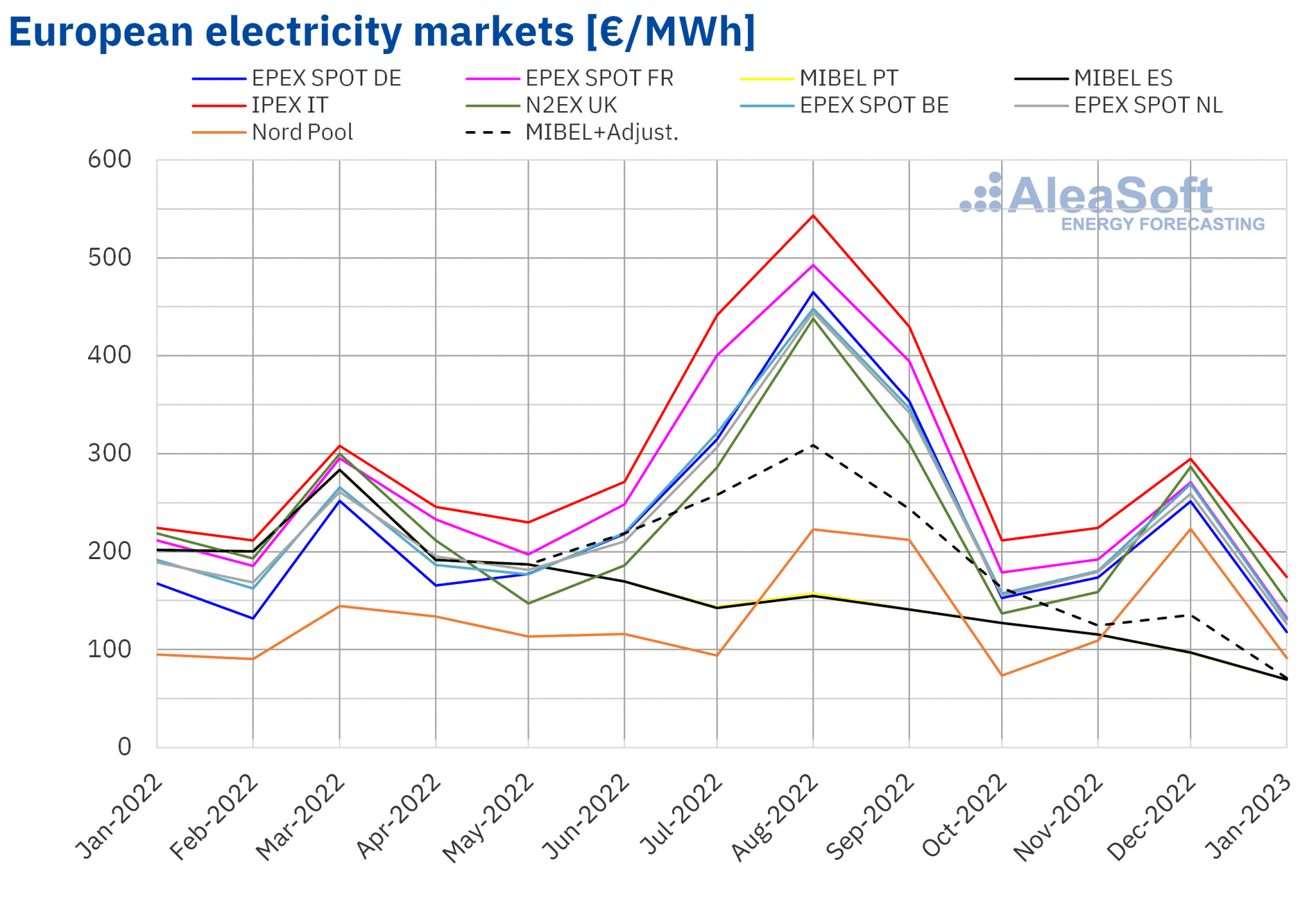Negative European Electricity Prices: A Solar Energy Success Story?

Table of Contents
Europe has recently witnessed an unprecedented phenomenon: negative electricity prices. This seemingly paradoxical situation – where producers actually pay consumers to take electricity – is sparking intense debate. Is it a testament to the success of the energy transition, driven by the explosive growth of solar power generation? Or does it signal deeper flaws in our electricity grid management and market design? This article delves into the causes and implications of negative electricity prices in Europe, examining the significant role of solar energy in this complex equation.
The Mechanics of Negative Electricity Prices
Oversupply of Renewable Energy
The root cause of negative electricity prices often lies in a simple imbalance: an oversupply of renewable energy, primarily solar and wind, exceeding current demand. This surplus occurs most frequently during peak sunshine hours, when solar photovoltaic (PV) systems are generating at maximum capacity, coinciding with periods of lower overall energy consumption.
- High solar irradiance: Periods of exceptionally strong sunlight lead to significantly higher-than-expected solar energy production.
- Low energy consumption periods: Midday, when many industries and businesses experience reduced energy needs, contributes to the surplus.
- Lack of sufficient energy storage solutions: The inability to store excess renewable energy efficiently exacerbates the problem, leading to a glut on the market.
This oversupply directly impacts pricing. Electricity markets often operate on a marginal pricing system, where the price is set by the most expensive source of electricity needed to meet demand at any given time. With abundant cheap renewable energy available, the marginal price can – and does – plummet, sometimes even below zero.
Grid Management Challenges
Managing the intermittent and fluctuating nature of renewable energy sources like solar and wind poses significant challenges to grid operators. Maintaining a stable electricity supply requires careful balancing of supply and demand in real-time.
- Balancing supply and demand in real-time: This is a constant juggling act, particularly when solar and wind output fluctuates wildly based on weather conditions.
- The role of conventional power plants: Traditional power plants, like coal and gas, are often needed to provide backup power and maintain grid stability, but their inflexibility makes them less efficient in managing this intermittent energy surplus.
- Limitations of current grid technology: Existing grid infrastructure wasn't designed for the high volumes of decentralized renewable energy generation, leading to bottlenecks and inefficiencies.
Curtailment – the deliberate reduction of renewable energy output – becomes a necessary evil to prevent grid instability during periods of significant oversupply. This, however, represents a lost opportunity to utilize clean energy and highlights the need for improved grid management strategies.
The Role of Solar Energy in Negative Price Events
Solar Power's Contribution
The rise of negative electricity prices is inextricably linked to the meteoric growth of solar photovoltaic (PV) installations across Europe. Declining solar panel costs and supportive government policies have driven widespread adoption.
- Increased solar PV capacity across Europe: Massive investments in solar farms and rooftop solar panels have significantly increased the continent's renewable energy capacity.
- Declining solar panel costs: The cost-effectiveness of solar energy has made it a highly competitive energy source.
- Supportive government policies: Government incentives and renewable energy targets have accelerated the deployment of solar PV systems.
Statistics clearly show solar energy's growing share in Europe's electricity mix. Its contribution is a major factor in creating periods of oversupply, leading to negative pricing scenarios.
Intermittency and Predictability
The intermittent nature of solar energy, dependent entirely on weather conditions, presents a challenge for grid stability. Accurate forecasting is crucial to mitigate these issues.
- Weather dependence: Cloud cover, seasonal variations, and even time of day heavily influence solar energy generation.
- Forecasting accuracy: Improving the accuracy of solar energy output forecasts is critical for better grid management.
- Demand-side management strategies: Implementing demand response programs, encouraging consumers to shift energy consumption to off-peak hours, can help balance supply and demand.
Advances in forecasting technologies and smart grid infrastructure are crucial to harnessing the benefits of solar power while minimizing its intermittency-related challenges.
Implications and Future Outlook
Economic Benefits and Drawbacks
Negative electricity prices have complex economic implications. While consumers might benefit from reduced electricity bills (or even payments for consuming electricity!), it presents challenges for conventional power plants, which struggle to compete with free renewable energy.
- Reduced electricity bills: In some cases, consumers can receive payments for consuming electricity during periods of oversupply.
- Challenges for conventional power plants: Traditional power plants struggle to operate profitably when electricity prices are negative or very low.
- Potential for energy arbitrage: Sophisticated players can profit by purchasing cheap or even free electricity and selling it when prices rise.
The long-term potential for cost savings due to increased renewable energy adoption is undeniable, but the transition requires careful management to avoid harming existing power plant infrastructure.
The Path Towards a Sustainable Energy System
To fully realize the benefits of solar energy and address the challenges of negative electricity prices, significant investments are needed in several key areas.
- Battery storage technologies: Large-scale energy storage is vital for storing excess renewable energy and releasing it when demand is high.
- Pumped hydro storage: This established technology offers a cost-effective and reliable large-scale storage solution.
- Demand response programs: Incentivizing consumers to shift energy consumption to off-peak hours can help balance supply and demand.
Integrated energy systems and market reforms are critical for navigating this energy transition. Moving beyond simple electricity markets to include a broader approach to energy management is necessary.
Conclusion
Negative European electricity prices, while initially perplexing, are a clear indicator of the significant progress Europe has made in deploying solar energy and other renewable sources. The phenomenon highlights the challenges of integrating intermittent renewable energy sources into existing grid infrastructure. The oversupply, largely driven by solar power's success, points to a need for substantial investment in smart grid technologies and large-scale energy storage solutions. While these negative prices present short-term challenges, they also underscore the growing success of solar energy in Europe's energy transition. Further investment in smart grid technologies and energy storage solutions is crucial to harness the full potential of solar power and ensure a stable and sustainable energy future. Embrace the positive aspects of the negative electricity prices phenomenon and continue supporting the growth of solar energy. Learn more about renewable energy solutions and how you can contribute to a greener future.

Featured Posts
-
 Donald Trump On Pete Rose Mlbs Decision Is A Shame Pardon Promised
Apr 29, 2025
Donald Trump On Pete Rose Mlbs Decision Is A Shame Pardon Promised
Apr 29, 2025 -
 Debunking Ai The Surprising Simplicity Of Its Thinking
Apr 29, 2025
Debunking Ai The Surprising Simplicity Of Its Thinking
Apr 29, 2025 -
 Jeff Goldblums Family Day Out Como 1907 Soccer Game
Apr 29, 2025
Jeff Goldblums Family Day Out Como 1907 Soccer Game
Apr 29, 2025 -
 New Documentary Showcases Willie Nelsons Respect For His Roadie
Apr 29, 2025
New Documentary Showcases Willie Nelsons Respect For His Roadie
Apr 29, 2025 -
 Managing Adhd The Benefits Of Group Support And Shared Strategies
Apr 29, 2025
Managing Adhd The Benefits Of Group Support And Shared Strategies
Apr 29, 2025
